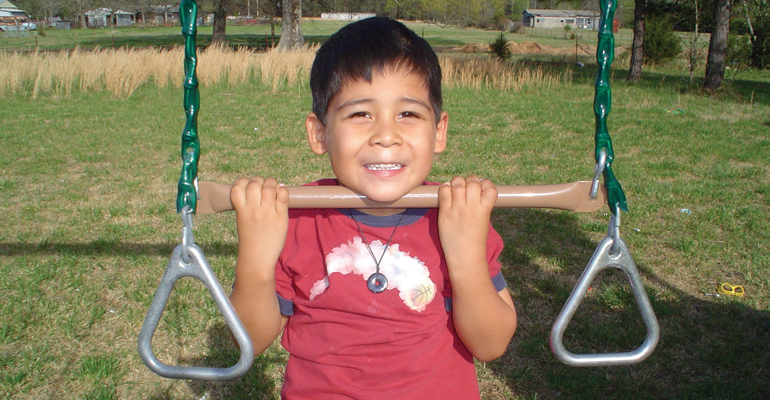You probably celebrate adoption every day in your house, but each November the rest of the country joins in for National Adoption Month. It is a month-long campaign to create awareness of adoption issues, including a festive National Adoption Day, when more than 300 events are held at courtrooms throughout the country to finalize adoptions.
While adoption of all kinds is celebrated this month, the national focus is on foster care and the 415,129 kids currently in the system — 107,918 of whom are waiting for forever families. More children become available for adoption each year than are adopted. According to the U.S. Department of Health and Human Services, in 2014, 60,898 children had parental rights terminated by the courts, yet only 50,644 were adopted. And that year, 22,392 kids aged out of the system without a permanent family or home.
That’s why Adoptive Families is bringing you this special feature on foster care adoption — to dispel the myths and rumors, and help you decide if adopting from foster care is the right way to expand your family.
Planning to Adopt
Things are different now in the child welfare system— and that’s good news for both kids and parents. “It used to be that you had to be a foster parent first in order to adopt, but that’s changed,” says Rita Soronen, executive director for the Dave Thomas Foundation for Adoption. “People can now state upfront that they want to be considered for adoption only.” That makes for a quicker process, with fewer broken hearts along the way.
Unlike foster care, in which the ultimate goal is reunification of the birth family, in adoption-only situations, the birth parents parental rights have been terminated before the child is placed with the pre-adoptive parents. “Once the termination of parental rights occurs, that family can’t come back and legally claim the child,” says Soronen.
But that doesn’t mean there is no contact with the birth family. Because many children in the foster system are older (the average age is eight), they often have ties to their families. Perhaps there is a grandparent who loves the child but was unable to care for her, or a sibling who was adopted by another family. Though the adoptive parent is not legally obligated to retain ties to the birth parents, keeping in touch with siblings and other relatives is often encouraged.
There’s no need to fear contact with the birth family, says Michelle Roberts, of Charleston, Illinois, who has adopted six girls from foster care. All of her children keep in touch with birth siblings. “It’s better for kids not to lose people they care about,” she says.
Roberts has also chosen to have some contact with the birth mothers, which has been positive for her girls. They could see for themselves that their birth families weren’t able to take care of them.
Fostering First
Because it takes three to six months at least to terminate parental rights, newborns are generally not available for adoption. Prospective parents who want an infant often go the foster care route first, with the hope of adopting later.
While the system’s first goal is to return the child to his birth family, about 30 percent of the children who enter foster care do not return home (and parents who express an interest in adoption receive foster children who are less likely to return home). “In many cases, the state will determine whether it is in the child’s best interest to stay with the foster parent,” says Kathy Ledesma, interim project director for the Collaboration to AdoptUSKids (adoptuskids.org).
That was the case with Sarah Gerstenzang, of Brooklyn, New York. She and her husband originally set out to foster-parent the five-week-old baby who came to live with them. After nearly two years of attempted rehabilitation of the birth mother, parental rights were terminated. It was clear that the best place for the baby was with Gerstenzang and her family, and they adopted her.
A foster parent’s duties often include helping the child reunite with her birth mother — an experience that can be awkward for those starting to bond with the child. In her memoir, Another Mother (Vanderbilt University Press), Gerstenzang writes about her daughter’s visits with the birth mother: “I noticed that she was upset when I picked her up after the visits — Cecilia would quiet as soon as I took her in my arms. This was disturbing to me.”
Dealing with Disappointment
While transitioning from fostering to adoption has its benefits — you’re bonding with the child early on, for instance — it can have heartbreaking consequences as well. “There is the risk that the child may return home, which can be emotionally trying on a family,” says Ledesma.
Michelle Bawek, of Bloomington, Minnesota, and her husband discovered that the hard way. Their first foster-care placement was a newborn straight from the hospital — and just a day later, they received a 15-month-old. “We became parents of two in two days!” recalls Bawek. Eight months later, they adopted the older child, and were hoping to adopt the younger one, as well.
Over the course of a year, Bawek and her husband had visited one of the baby’s relatives, who was deciding whether she could care for the baby. When it seemed unlikely that this would happen, the Baweks signed an intent to adopt— then the relative changed her mind at the last minute. “We were feeling really positive, and then we received a call out of the blue saying that she would be removed in two weeks,” says Bawek. “She was our heartbreak. My greatest concern was, what is this little girl thinking? I’m the mommy who took her home from the hospital, now I’m handing her over to this strange woman. Was she wondering, where is my mommy?”
Though it took Michelle and her husband more than a year of healing, they did become foster parents again — they have adopted three children from foster care and have one biological child. The experience has taught a powerful parenting lesson. “The most important thing, as a parent, is flexibility, and our life is a roller-coaster ride,” Bawek says.
While adopting a child from foster care isn’t for everyone, it can be a deeply rewarding way to form or expand a family. “Ultimately, what it comes down to, for a potential adoptive parent, is to be aware of both the system and the needs of its children,” says Soronen. “You have to move from a selfish sense of needing love from a child to an altruistic sense of wanting to give to a child.” Bawek adds, “If you’re feeling compelled to do it, just do it — jump in with both feet!”
Adoption Agencies with U.S. Foster Adoption Programs
See all adoption agencies with U.S. foster adoption programs >



